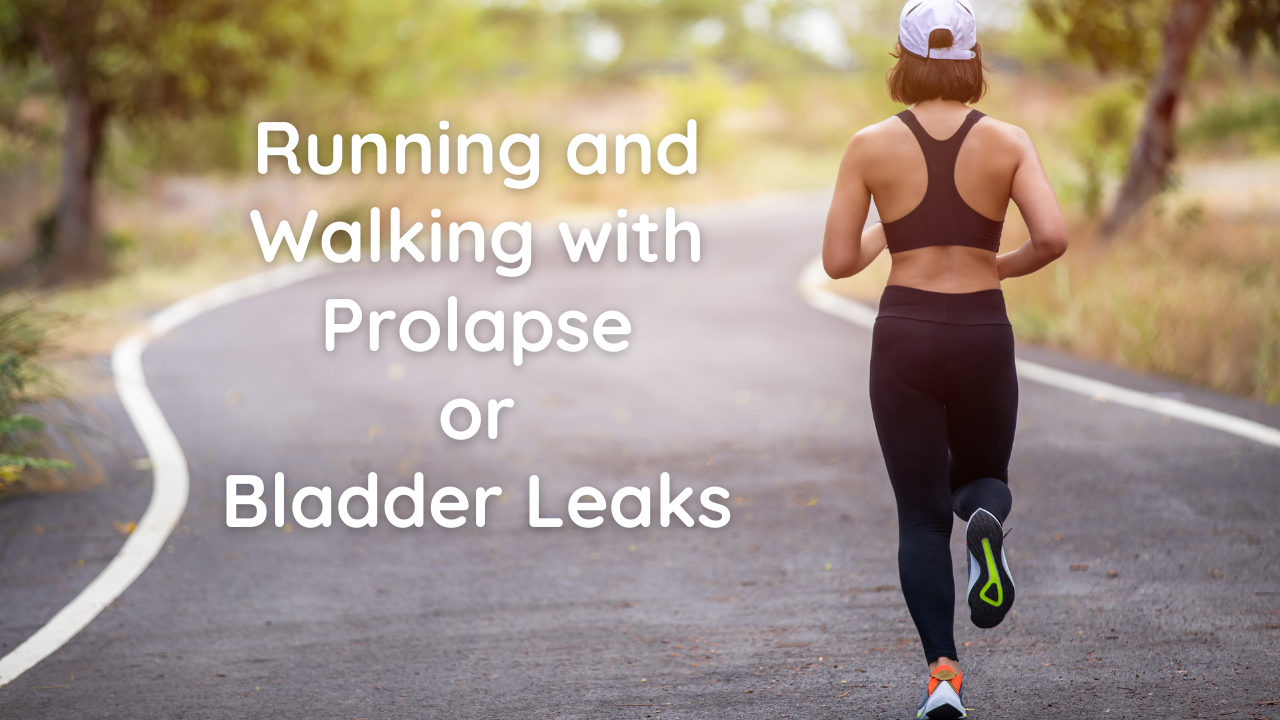Walking and Running with Prolapse or Bladder Leaks

Tips for running with prolapse or bladder leaks from a physical therapist with 30 years of experience running and walking for fitness, 20+ years of experience studying physiology, and 15+ years specializing in pelvic health! Read on:
Walking and running are not just exercises for your physical body... For many people, walking and/or running is MEDICINE FOR THE SOUL. For those of us who are walkers or runners, it's our "prescription" for mental and emotional well-being, as well as a great way to strengthen the body and burn calories!
Unfortunately, many people feel that their days of walking and/or running for fitness are over once they receive a prolapse diagnosis, or if they experience bladder leakage.
Your days of running or walking for fitness are NOT over... You simply need to "tweak" your routine and some of your habits, and gradually rebuild from there. In addition to the following tips, I recommend consulting with a local pelvic floor specialist (physical therapist or occupational therapist) and checking out my Lift program for at-home support.
Tips for Walking and Running with Prolapse or Bladder Leaks
1) Float your ribcage above your pelvis.
You can breathe best, and your core muscles (including your pelvic floor) will work best, when your body is properly aligned.
Many people — including myself — thrust their ribs forward and up when walking or running. This is sometimes called rib popping or rib flaring. When you thrust/pop/flare your ribs, notice how your back ribs can't expand out to the sides (for best breathing) and how your core is out of alignment.
In the "ribs over pelvis" image on the left, your core container — including the pelvic floor, abs, breathing diaphragm, and back — are lined up for maximum efficiency and effectiveness.
In the "rib thrusting" image on the right, the abs are long and overstretched (meaning they won't work well), the back muscles are short and tight/cramped (meaning they won't work well) and the breathing diaphragm and pelvic floor are off-kilter as well (again... they won't work well). Additionally, the black circle around the lower back ribs indicates that when they're compressed, your ribs can't laterally expand to allow full, deep breathing.

When I walk for fitness, I check in with myself and NOTICE when my ribs are thrusting and my thoracic spine is overly extended. This usually occurs when I'm walking quickly, or when I'm walking up or down hills. If I notice this alignment issue, I gently move my ribcage back, so that it's "floating" above my pelvis.
Note: when I float my ribs back, my shoulders round forward and my chest muscles feel tight in the front. So when I float my ribs back, I have to adjust my shoulder position, too.
Proper alignment for rib thrusters often requires opening tight shoulder and chest muscles and strengthening the mid back. Try this video:
2) Your vagina isn't made of concrete! Don't clench.
Many people with prolapse or bladder leakage subconsciously contract their pelvic floor, keeping their vaginal walls rigid (and inadvertently squeezing around any prolapsed organs). But your vagina is NOT made of concrete. It's meant to be mobile, supple, and responsive when walking... Not clenched the whole time!
Do we want our legs to be two solid concrete blocks?
No way! We want our legs to be able to flex and extend, to contract and relax, and we trust that this dynamic action will happen naturally when we're walking or running... It's the same with our pelvic floor muscles!
This is one reason I love exercising on my trampoline (Rebounder)... It reminds me that my core/pelvic floor is meant to be fluid and dynamic, not hard and rigid. Even if I'm gently engaged through my core, it can still be supple and responsive when exercising... NEVER hard, rigid, or clenched.
When walking or running, imagine that your pelvic floor is like a fluid, supple, floaty "magic carpet," gently supporting you as you move and breathe.

3) Work up to longer distances slowly.
Your body is always sending you messages. Sometimes these messages include pelvic heaviness or bulging, low back pain, or bladder leakage when you're walking. Chances are, if you're reading this blog post, you've been getting these types of messages from your body!
These messages don't mean that you'll never be able to walk or run again... They simply mean that something needs to be adjusted. They're saying, "Listen to me!!! You're pushing yourself past your current limits!"
So while you don't need to stop completely, you do need to BACK OFF while you seek help for your pelvic health and begin utilizing the concepts in this blog post.
If you've been receiving signals such as pelvic heaviness or bladder leakage, then the distance you typically walk or run is currently TOO MUCH. You've reached (and surpassed) your threshold.
The key is to find your current threshold without going past it. If you typically have symptoms after 30 minutes of your activity, then back off to 15-20 minutes, and supplement with another form of exercise later in the day (or break up your 30-minute walk into two shorter sessions).

Another option: If your 30-minute run creates symptoms, then instead of running steadily, try intervals of running interspersed with intervals of walking.
There are many ways to back off without stopping completely. While you're working with your body's current limits and needs, you can gradually rebuild your foundational core strength and your capacity for longer distances. My Lift program can help you with that!
4) Use a pessary if needed.
Pessaries are like a sports bra for your vagina. There are many different types of pessaries, and even if you don't use a pessary all the time, it can be really helpful to use during exercise. Think of it like an orthotic for your running shoes! You don't necessarily use the orthotics all the time, they're not in every pair of dress shoes or sandals, but they can be essential when you go out on a long walk or run.
I have a blog post (with video embedded) about pessaries here. While it's ideal to be fitted for a pessary, many walkers and runners have experienced relief by using temporary devices such as Poise Impressa Bladder Supports. I don't love that Impressa is a disposable one-time-use product (not good for the environment), but it's a more comfortable option than using a tampon for temporary support. Tampons can be a reasonable option, but insertion and removal of a dry tampon is uncomfortable and irritating to delicate vaginal tissues.
5) Hips up time after.
Even if you don't feel like you need it, I highly recommend a few minutes of hips-up time AFTER your run or your walk. Learn all about the benefits of hips-up time in this video:
And a little BONUS TIP! Try walking or running in the morning, when your pelvic floor is strongest and most energized, rather than later in the day when your muscles are already fatigued.
SPECIFICALLY FOR RUNNERS:
If you're reading this and you're a runner, the following tips (and video) are specifically for you! You'll learn myths about running with prolapse or bladder leaks, plus top tips to help including:
- "ABC" walking and running
- The importance of NOT CLENCHING
- Do NOT hold a kegel while you're running!!!
- Timing
- My "3 Deep Breaths" trick
Runners: I also encourage you to rebuild your pelvic floor/core foundation slowly, from the ground up, using info from my "return to running" program that's part of the bonus content of Lift. You can also use my prolapse-safe jump prep workout below!
As I often say, sometimes you have to SLOW DOWN in order to SPEED UP.
By backing off now, and re-building your foundation gradually, you'll end up stronger than ever and you can get back to your distances in a way that's SAFE and symptom-free.
REBUILD YOUR FOUNDATION: Check out my Lift program here!
Does your pelvic floor need help?
Many women think they just need live with the changes they’re experiencing
“down there,” but this is NOT the case. Take the short quiz to find out if you have issues that can be solved naturally.







